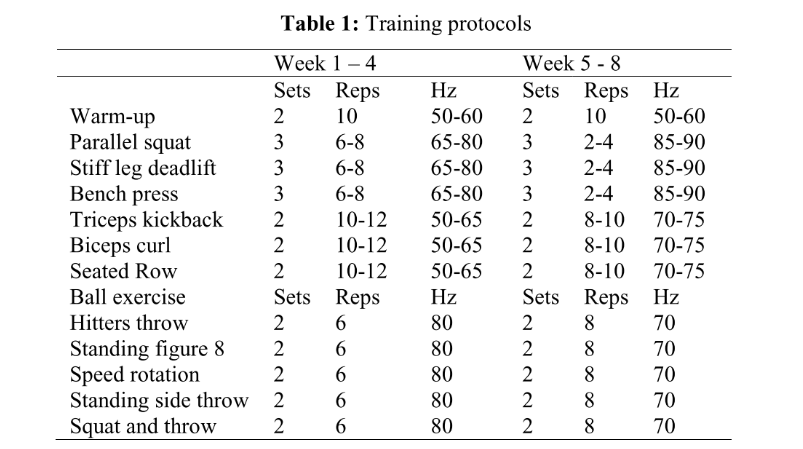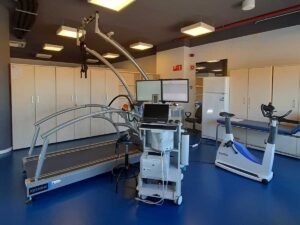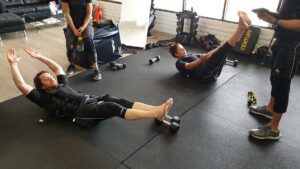Batting speed is an essential component for successful hitting in softball and baseball sports [2,3]. In one study it was found that batting speed can be increased through sport-specific gesture training and muscle strength can be increased [4]. Furthermore, in other studies it was found that the increase in rotational force of the trunk, upper body and lower body has a significant relationship with batting speed [5].
On the other hand, training with Whole body electrostimulation (WB-EMS) has had positive effects in the improvement of muscle mass and in the loss of abdominal fat, Also, in the improvement of energy expenditure, improvement in metabolic rate at rest, body composition and maximum strength in older and sedentary women [6,7,8]. Therefore, this study aimed to quantify the effects of WB-EMS on maximum strength, as well as batting speed in softball players.
Forty softball players participated in this study and were randomly assigned to two groups: Group with WB-EMS and group without WB-EMS. Both groups made 100 basic bats in each session using a standard bat. Additionally, after basic batting, electrostimulation was applied to the group with WB-EMS. The training program was carried out three times a week and all the participants were tested before and after the 8 weeks of training.
For this study, a full body electrostimulation device with a balanced, biphasic, quadrangular, and balanced wave was applied. In the following table 1 we can see the electrostimulation protocol that was followed during the training program. Between 2 and 3 series were applied with repetitions between 6 and 12 with medium (50-65 Hz) and high (70-90 Hz) frequency. In the first 4 weeks, the medium frequency was applied to a greater extent, and in the last 4 weeks, only the high frequency was applied, with the exception of warming.

In the test procedures, the maximum force of 1 RM of the upper body, lower body, and trunk rotation was estimated. For this, a 3 RM test (lifting the maximum weight in three repetitions) was performed in the bench press, squat and trunk rotation. This test was applied before 4 weeks of training and after 8 weeks. On the other hand, batting speed was measured the day after the 3 RM test. Before measuring batting speed, dynamic full body exercises were performed for 5 minutes as a warm-up. A specific speed measurement device was used for the test. Participants batted 5 times with a 30 second break between series and series.
After 8 weeks of training, the WB-EMS group showed an improvement in maximal upper body, lower body, and trunk rotation strength compared to the group without electrostimulation.

Analyzing all of the above, we can conclude that three dynamic sessions of WB-EMS in combination with 300 batting repetitions per week is more effective than batting training without WB-EMS in improving maximum strength and batting speed. in college softball players. This study demonstrated that a specific softball training in conjunction with WB-EMS is very effective in achieving the programmed goals in training.
Informative note
This study does not specify whether study participants underwent prior adaptation to WB-EMS. Therefore, from Wiemspro we advise that before applying a WB-EMS training protocol, an adaptation period must be passed with a frequency below 50 Hz without reaching electrostimulation intensities that can cause high exhaustion for at least 6 -8 sessions.
Bibliography
- Nurul, Raja Raja, Jannat Mea, Kee Kang Razman, Rizal Ismail, Shariman Ismadi Shari, Maisarah Idris, Norizzati Mohd Sciences, Exercise. (2019). EFFECTS OF WHOLE-BODY ELECTROMYOSTIMULATION ON STRENGTH AND BATTING VELOCITY OF FEMALE COLLEGIATE. Malaysian Journal of Movement, Health & Exercise,, 8, 175-184.
- Szymanski, D. J., DeRenne, C., & Spaniol, F. (2009). Contributing factors for increased bat swing velocity. The Journal of Strength & Conditioning Research, 23(4), 1338-1352.
- Wilson, J. M., Miller, A. L., Szymanski, D. J., Duncan, N. M., Andersen, J. C., Alcantara, Z. G., . . . Bergman, C. J. (2012). Effects of various warm-up devices and rest period lengths on batting velocity and acceleration of intercollegiate baseball players. The Journal of Strength & Conditioning Research, 26(9), 2317-2323.
- Szymanski, D. J., Albert, J., Hemperley, D., Hsu, H., Moore, R., Potts, J., Reed, J. E., Walker, J. P. & Winstead, R. C. (2008). Effect of overweighted forearm training on bat swing and batted-ball velocities of high school baseball players. J Strength Cond Res, 22, 109-110.
- Szymanski, D. J., McIntyre, J., Szymanski, J., Bradford, T., Schade, R., Madsen, N., & Pascoe, D. (2007). Effect of torso rotational strength on angular hip, angular shoulder, and linear bat velocities of high school baseball players. The Journal of Strength & Conditioning Research, 21(4), 1117-1125.
- Kemmler, W., & von Stengel, S. (2013). Whole-body electromyostimulation as a means to impact muscle mass and abdominal body fat in lean, sedentary, older female adults: subanalysis of the TEST-III trial. Clinical interventions in aging, 8, 1353.
- Kemmler, W., Von Stengel, S., Schwarz, J., & Mayhew, J. L. (2012). Effect of whole-body electromyostimulation on energy expenditure during exercise. The Journal of Strength & Conditioning Research, 26(1), 240-245.
- Kemmler, W., Schliffka, R., Mayhew, J. L., & von Stengel, S. (2010). Effects of whole-body electromyostimulation on resting metabolic rate, body composition, and maximum strength in postmenopausal women: The training and electrostimulation trial. The Journal of Strength & Conditioning Research, 24(7), 1880-1887.







